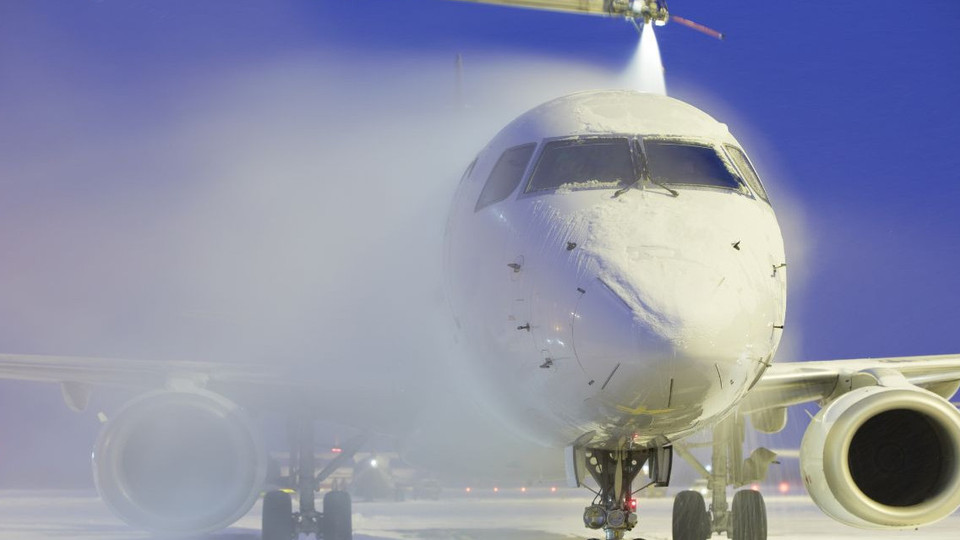Jun 19, 2019 Jan Uphues
ShareGet hot in summer, get HOT in winter. I frequently use this corny pun to introduce the topic of aircraft de-icing. There is a connection to HOT, I promise I’ll reveal it later. First, picture yourself aboard an aircraft in the midst of a deep winter at the airport, waiting to depart. You may have experienced it yourself: There’s a sudden announcement that the aircraft is delayed because de-icing is required. Though the announcement doesn’t come as a big surprise, considering the harsh weather, you hear a collective fatalistic groan along the seat rows. Outside the aircraft, there are mutual feelings: De-icing is a challenge for planners and dispatchers as it often means a disruption which causes extra costs and delays. And as the snow falls on the entire region, there is usually a lot more than one aircraft to be de-iced. Remember, the weather affects us all and is a major factor why On-Time Performance (OTP) cannot be achieved temporarily. Still, the decision to de-ice is a clear sign of responsibility.
AIRCRAFT DE-ICING "ON THE FLY"
In fact, ice on the aircraft could potentially be a problem throughout the year. Even at midsummer temperatures on the ground, at altitudes of 35,000 feet and more it is freezing cold, often below minus 50 degrees Celsius. Consequently, glaciation also occurs in flight, for example through thermal winds that carry humid air into high layers, or when flying through clouds. At these high altitudes, the water droplets are liquid, even far below the actual freezing point. But this can suddenly change when they hit a solid, cold surface such as the wings of a plane. The risk of water quickly turning into ice is greatest when the aircraft descends and the frozen aircraft hits the humid air layers. This is potentially dangerous: The aerodynamics of the aircraft are affected and the fuel consumption increases. In the worst case, this may disrupt the airflow around the wings, affect the lift or even freeze control surfaces. ICAO estimates that ice on wings can reduce wing lift by as much as 30% and increase drag by 40%. That would have a very serious, negative impact on a takeoff roll.
However, this doesn’t happen all the time, because the aircraft is also de-iced in the air. Smaller and larger planes have different tools to get rid of the ice. For instance, a Boeing 787 uses heating elements in the wings as well as nozzles that can spray strong alcoholic solutions.
AIRCRAFT DE-ICING ON THE GROUND
On the ground, de-icing is the process of removing snow, slush or ice from the fuselage, wings and control surfaces with external help. It is up to the captain of the aircraft to decide whether or not to de-ice. Unfortunately, the process doesn’t come cheap: The price for de-icing an average passenger aircraft can cost an airline well over 6,000 Euros for just one coating, and can wipeout the entire profit margin for that flight.
Here's how the process works to keep aircraft, crew and passengers safe in the skies. The first fluid used is propylene glycol, heated to around 60-65 degrees Celsius, and sprayed onto all required surfaces of the aircraft at a high pressure by de-icing trucks to blast off “contaminants”. A second step, called anti-icing, may also be required. According to ICAO, the basic function of an anti-icing fluid is to prevent frozen or freezing precipitation or expected frost from adhering to the aircraft’s cleaned or de-iced surfaces. This brings us to one of the key challenges of de-icing. When an aircraft is de-iced, depending on weather conditions and temperature, it only takes a short time until a new layer of ice forms on the surfaces, making a departure impossible again. Therefore, a freshly de-iced plane should depart as quickly as possible.
WHAT´S HOT?
As promised, here’s the explanation behind the introductory pun: In order to know how much time remains for a safe departure, a Holdover Time (HOT) is set. This defines the time between completion of the de-icing process and the latest possible lift-off time for the aircraft before a new layer of ice forms. To designate the HOT, the crews must consider the current temperature, the type of precipitation that is falling and the time taken to depart. It can range from as little as 15 minutes in more moderate conditions like light snow or ice pellets to hours in heavy snow. Under very severe conditions such as freezing rain, anti-icing solutions offer no protection and takeoffs will not be authorized.
If the holdover time is exceeded and the aircraft has not yet departed, the captain has to make a choice: return for more de-icing and anti-icing, or conduct a visual inspection of the wings. Due to the unpredictable nature of these weather conditions, a lot of staff and equipment are required to receive and fulfill tasks on the spot. To keep resource output as low as possible, – it costs a ton of money! – careful planning, as well as quick and precise assignments on the day of operation are necessary. The aircraft de-icing market is expected to reach $1.3 billion by 2020, to register a CAGR of 5.18%. The growth is expected to be driven by modernization and airport expansion in the North American and European regions, along with the need for safe takeoff and landing operations. The planning and assignment of staff and GSE is one of the biggest challenges in the daily operation now more than ever.
Ever been stuck on a frozen aircraft? Did you experience the de-icing process yourself? Were you angry about the delay or grateful that they did it for your safety? Let us know your experiences!
About our Expert

Jan Uphues
Marketing Manager
From the exhilarating rush of his very first flight, Jan Uphues was captivated by the world of aviation. Though that maiden voyage had its jittery moments, it set the course for a lifelong passion. Starting at INFORM in 2018, he combined it with his second love: crafting compelling content.


